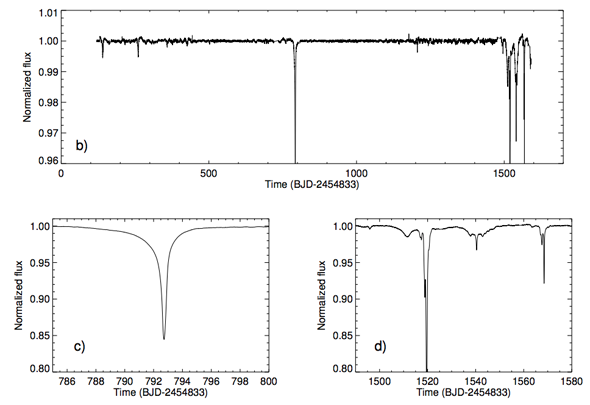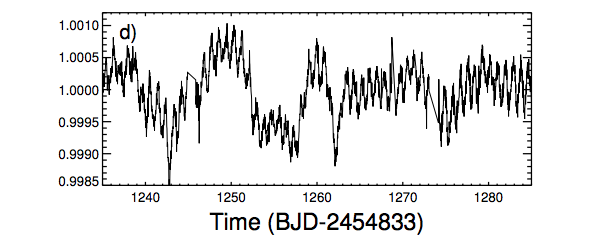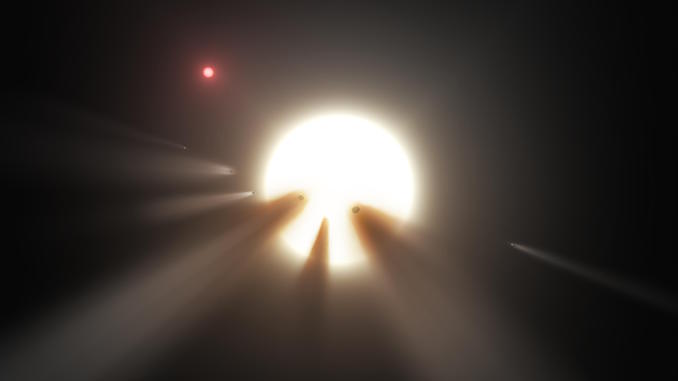The star with the Dyson sphere continues to put puzzles in front of scientists
Researchers claim that the change in luminosity of a star is uneven and very fast.

Source: popsci.com
Last October, astronomers discovered the star KIC 8462852 with unusual luminosity dynamics. Scientists who made this discovery have suggested that the strange dynamics can be explained by the movement of objects that are in orbit around a star. Some experts have suggested that the star may be in the Dyson sphere. The star is located in 1480 light years from Earth.
On October 19, 2015, the SETI Institute notified about the start of observations of radio emission from a possible extraterrestrial civilization near the star using the Allen Telescope Array radio telescope. After two weeks of preliminary observations, the SETI representatives stated that the radio signal from the KIC 8462852 stellar system revealed no undoubted signs of its artificial origin. Allen Telescope Array is a system of large antennas, which is located 480 km north of San Francisco.
A few weeks after the discovery, it was suggested that swarms of comets scamper around the star, which influence the luminosity of KIC 8462852. After some time, this theory was refuted. Bradley Schaefer (Bradley Schaefer) studied the luminosity of a star from 1890 to 1989, analyzing a number of scans of historical photographs of a portion of the sky with a strange star. As it turned out, over a hundred years, its luminosity decreased by 20%. According to Schaefer’s calculations, in order to darken a star so much, there must be at least 648,000 comets at a time, each with a diameter of 200 km. And this is too unbelievable to be true.
')
Now the conclusions of Schaefer confirmed a group of astronomers from the California Institute of Technology and the Carnegie Institute in the United States. The Americans studied the images obtained by the Kepler telescope in the first 4 years of work in orbit. As it turned out, the luminosity of the star during this time significantly decreased. Every year it falls by 0.341%. In addition, the fact of rapid and irregular changes in luminosity is confirmed. As previously reported, these changes are very significant: for one extinction, the brightness can drop by 15%, and then by 22%. After that, the luminosity of the star is usually restored.

Scientists failed to identify patterns of changes in luminosity. Astronomers observed not only long-term extinctions, but dimming for a week, two, with luminosity recovering over time.

The peculiarity of the Kepler telescope is that when searching for exoplanets, a special algorithm cuts off all blackouts lasting more than a few hours. The darkening of a star's disk by the planet usually takes much less time. But every month the telescope makes a full-frame image to calibrate and adjust the field of view. Every three months he changes his position by 90 degrees in order to close the photosensitive equipment with a special shield from the Sun. That is, every three months, KIC 8462852 appears in the same spot of the picture.
The Americans studied 52 full-frame RAW-images of the Kepler telescope with the image of KIC 8462852. They found something quite unusual. It turned out that every year the star's brightness drops by 0.341%, which is twice the value specified by Schaefer. Such dynamics persisted for 1100 days of observation of the telescope at this point. But then, from 1100 to 1300, the day Kepler worked, the speed of darkening increased dramatically. The star lost 2.5% luminosity in just 200 days. After this, the fall rate of the luminosity KIC 8462852 returned to its original value. One possible explanation for this strange behavior of a star is the passage of a cloud of gas across its disk. Different parts of the cloud have different densities, which changes the observed brightness of KIC 8462852 without apparent periodicity.
"There are three timelines for all the events taking place," says one of the study participants. “Short-term events lasting for several days, which were originally opened. Medium-term events lasting six months and long-term, the duration of which is at least three years. Everything that happens with this star is amazing. ”

Star events from 0 to 1600 days of the Kepler telescope
Long blackout
Unfortunately, the data obtained by the orbiting telescope cannot confirm or deny the information published by Schaefer. Too much difference in the timing of observation. The photographs analyzed by the physicist cover a period of almost a hundred years, between 1890 and 1989. The Kepler telescope was launched only in 2009. Information obtained by the orbital telescope suggests that the star has become increasingly dim since 2009. And the speed of darkening of the star is higher than that indicated by Schaefer. American experts point out that there is no problem here - perhaps the rate of decrease in the luminosity of a star has grown since 1989. Moreover, the data obtained by the Kepler telescope from 1100 to 1300 days of his work suggest that just the changes in the brightness of a star are not constant. This is a value that does not have a visible link to any factors. The star may dim almost before his eyes, and then return to the previous level of luminosity. Schaefer worked with photographs that do not allow us to determine whether the star tarnishing process is a constant, or whether this value varies within certain limits.
KIC 8462852 is a very interesting object to study, and recently an amount of $ 100,000 was collected on Kickstarter to continue research.

American scientists say in their work that now it is not possible to explain all changes in the brightness of the star KIC 8462852. Can any phenomena make up a chain that will lead to observable oddities in the star's behavior? Scientists doubt it. “We cannot argue that a combination of unusual phenomena that lead to the observed result is impossible. But this is unlikely and does not provide a satisfactory scientific explanation, ”says Tabetha Boyajian, lead author of the study.
Perhaps a scientific explanation remains to be found. Now scientists are studying photos of stars from different observatories. Part of the funds received with the help of Kickstarter will be spent on working with the LCOGT network (Las Cumbres Observatory Global Telescope Network). Scientists hope that it will be LCOGT that will find the answer, or at least part of the answer to the question of what is the star KIC 8462852 and why it behaves so strangely.
Source: https://habr.com/ru/post/372561/
All Articles